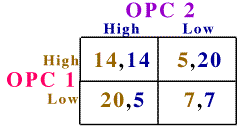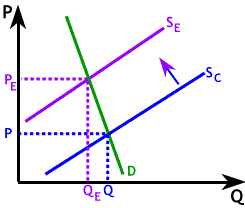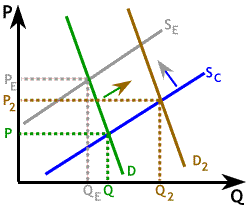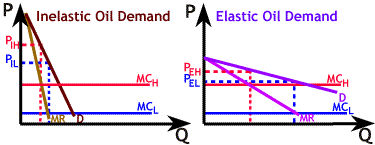

The immediate reason for the price increase was an announcement by ten of the major oil-producing nations in which they pledged to reduce oil production. Among those who agreed to reduce output was Mexico, a major oil producing country which is not a member of OPEC (Organization of Petroleum Exporting Countries). Mexico's participation in attempts by these countries to reduce production is unusual and one of the reasons the reduction in output is likely to stick for a while.

One interesting aspect of this announcement is that prices rose as a result of the announcement. It was too soon for actual changes in production to have any impact, but the expectation of reduced output was sufficient to affect prices.
The graph to the right shows what is expected to occur in markets for crude oil, as well as refined oil products (such as gasoline and heating oil). SC represents the current supply of oil and SE represents the expected supply if Mexico and OPEC countries reduce output. Demand for these products, shown as D, is typically very inelastic (since there are few close substitutes). Therefore, supply reductions typically cause prices to rise quickly, and total quantity used to fall only slightly.

As we learned in the Expectations subsection of the Demand & Supply section, the expectation of a price increase shifts out demand immediately (as shown to the left). Because demand shifts from D to D2 price starts to rise immediately to P2, even without any change in actual supply behavior. This is one possible explanation for the instantaneous rise in oil prices due to the announcement by the oil producing countries.

The fact is, however, that the expectation of a price increase is also sufficient to immediately force the supply curve back. The realization that oil prices will increase means that current oil is suddenly more valuable. Since oil is easily stored, suppliers are willing to supply less at every price when higher prices are expected. The immediate price increase (whether generated on the demand side or the supply side) is purely the result of changing expectations about the future prices and production levels of oil. These changes occurred before production had time to change. If the oil producing countries are able to agree to restrict output, these expectations will be realized and prices will stay higher or rise even more.
Suppose oil prices do stay higher. Are the price increases passed along equally to all users, or do some types of users of petroleum products bear more of the price increase than others?
Petroleum based products are used directly or indirectly everywhere, but some users have more inelastic demand that others. Demand for gasoline, jet fuel, diesel fuel and home heating tend to be relatively inelastic. Demand for heating and plant power for large enterprises is somewhat more elastic.
There are no good substitutes for gasoline, jet fuel, or diesel fuel. Therefore, individuals and firms who depend on these products tend to have very inelastic demands. While homes can be heated with natural gas or electricity, a costly (relative to the price increase) new heating system is required, making homeowner demand for heating oil relatively inelastic. This may not be true for large corporate users of petroleum as a heating fuel or to power a manufacturing operation. In these cases, the vast quantities of petroleum products used means that a small price increase can quickly overwhelm the cost of replacing equipment, allowing the firm to use natural gas, electricity, or steam. For this reason, large business users who use petroleum for heating and plant power have more elastic demand.

As shown to the right, users with a more inelastic demand for oil bear a larger portion of the price increase. Thus, the price of gasoline, home heating oil, jet fuel and diesel fuel will show significant price increases as the marginal cost of oil rises from MCL to MCH. Keep in mind, the graphs to the right are exaggerated to illustrate the point.

If the reductions in oil production stick, gasoline prices can be expected to continue to increase. The reduced production will cause prices to increase, but gasoline prices typically increase during the spring and summer anyway. Warm weather and vacations contribute to much more driving and a seasonal increase in gasoline demand, which translates into higher prices.
The graph to the left shows the effect of increased demand on gasoline prices. DW represents Winter demand for gasoline. During the Spring and Summer months demand increases to DS causing price to rise ever more, from PW to PS.
If the major Oil Producing countries can maintain reduced output, oil prices will remain elevated and may rise even higher. These countries face a classic prisoner's dilemma or oligopolists' dilemma. Indeed, the desire to cheat on agreements to reduce output is so compelling that these countries haven't been successful at maintaining low output and high prices for many years.
The payoff matrix to the right might be a good representation of the game faced by Oil Producing Countries (OPC) (since Mexico isn't a member of OPEC but has agreed to reduce output, we're using the broader category of Oil Producing Countries). Naturally we can view this as a repeated game. A country may change its oil production targets several times each year so the game is repeated frequently and has been for decades.

The agreement the OPCs are attempting to maintain is one in which oil production is reduced by all countries involved: leading to Higher prices for crude oil, and greater profits for the OPCs.
As we learned in the section on repeated games, collusive agreements are easier to maintain in some circumstances than in others. The Oil Producing Countries face a situation in which collusion is more difficult to maintain for several reasons.
A great many factors make it difficult for these countries to successfully collude on maintaining reduced oil production. The fact that they have failed for so long to maintain low output suggests that, once again, they may find such agreements exceedingly difficult to sustain. Only time will tell if the countries can stick to the collusive agreement or if one or more countries will cheat; again sending world prices for oil and petroleum products lower.
A change in the price of a company's stock is a good indicator of a change in the belief of investors about the future profitability of that company. The announcement of the production cutbacks by oil producing countries leads to a drop in stock prices for companies in the transportation business who rely on jet and diesel fuel, and an increase in the stock price of petroleum companies. Indeed, a great many stock prices changed due to the announcement.
Petroleum is such a huge part of modern economies that the effects of a price change are too many to completely cover here. If prices continue to increase we'll take a look at some of the long-term implications of expensive oil in a future current event article.
Copyright © 1995-2003 OnLineTexts.com, Inc. - All Rights Reserved